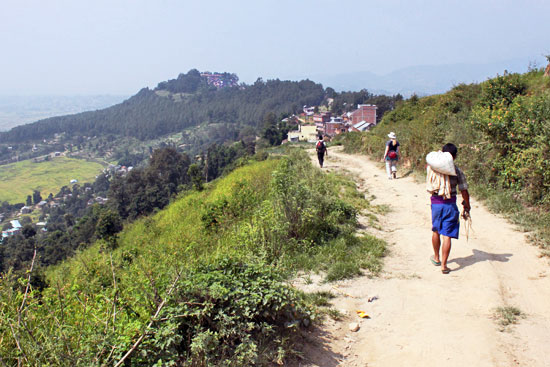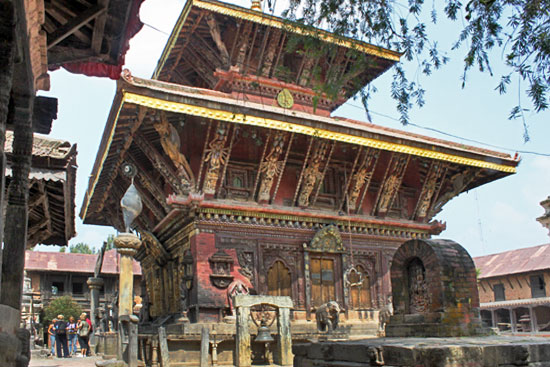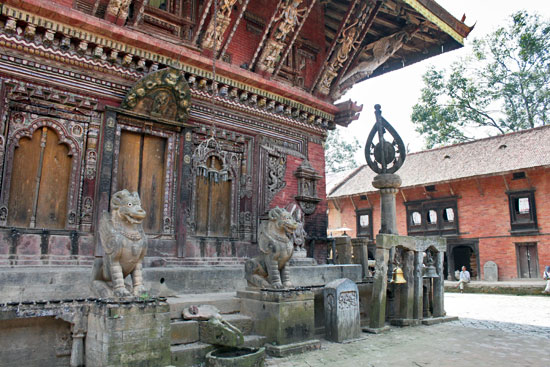Each time I arrive in Kathmandu, Nepal, I am awed by the kaleidoscope of silk saris that enliven its dusty streets, the canted brick buildings with old wooden doors painted in rainbow colors, and the stoic women vendors who patiently squat next to paltry piles of produce amidst the squalor. But I can only take so much of the seething crowds, the pollution, and the ear-splitting horns of motorcycles that streak through the narrow lanes, passing just inches from pedestrians who share the asphalt. After a week, my senses are overloaded and I flee to serene Pokhara. Because I’ve had to experience Kathmandu in bits and pieces it has taken me three years to see all seven of the UNESCO World Heritage places to visit in Kathmandu.

Kathmandu sits in the center of a valley that is roughly shaped like an oval bowl that legend says was once a lake surrounded by hills. One day, the Bodhisattva Manjushree visited on a pilgrimage and saw a bright flame coming from a huge lotus in the center of the lake. Wishing to worship the flower, he cut a deep gorge in the hills with his sword, allowing the water to drain from the valley. Over the ensuing centuries, three separate kingdoms arose within the fertile valley. The rulers of each constructed magnificent medieval palaces surrounded by plazas known as Durbar (Palace) Square. Today we know these royal cities as Kathmandu, Bhaktapur, and Patan (Lalitpur District). In 1769, Prithvi Narayan Shah conquered and unified the three kingdoms, creating the country of Nepal.
My first visit to the capital city was in October of 2010 during Dashain (Duh SAW ee), the most important Hindu religious festival of the year. From my hostel I planned to walk to Kathmandu Durbar Square, the first of the UNESCO World Heritage Sites, but the streets were a maze of neon lights, billboards, and ramshackle buildings, teeming with shoulder-to shoulder holiday shoppers. With no available map, no street signs, and not a word of Nepali at my command, I knew I would never find the site on my own. Instead, I climbed aboard a tippy rickshaw and settled back as my driver wound a torturous path through the throngs. A dizzying 20-minutes later, I clambered down and joined the masses streaming through Kathmandu Durbar Square.
I hardly knew where to look first. In front of me was the 12-foot high stone carving of Kala Bhairava, the god of destruction, thought to be the manifestation of Shiva in his frightening aspect. Hindus believe that anyone who speaks falsely before this sculpture will die, thus it served as Nepal’s Supreme Court for many years. Around the next corner I came under the watchful gaze of Lord Shiva and his consort Parvati, looking out from a second story window of the house built for them by King Rana Bahadur Shah.
Cant view the above slide show of Kathmandu Durbar Square in Nepal? Click here.
Taking a cue from the divine couple, I climbed the steep concrete steps of one of the temples for a breathtaking view over the square. In front of me spread the dazzling white colonnaded Royal Palace, flanked by the house of the Living Goddess, Kumari. There are several Kumaris throughout Nepal but the best known is the Royal Kumari of Kathmandu, thought to be the incarnation of the goddess Taleju. Kumari serves until she menstruates, after which the goddess leaves her body and the search for a new Living Goddess begins. Chosen from the Newari caste of Sakya goldsmiths, a Kumari must have thirty-two virtues, including fearlessness, an unblemished body, the voice of a bird, and the neck of a duck. Potential candidates are taken to a room filled with severed animal heads to test their courage; the one that shows no fear is the chosen one. On the day I visited, as on all days, faithful had gathered on the pavement beneath the elaborately carved wooden windows of the Kumari House, hoping that she would pass by, as even a glimpse of her is believed to bring good fortune.
Back down at ground level, I was perusing the wood carvings on the eaves of some of the minor temples when an enterprising tout began chatting me up. “They are erotic tantric carvings,” he said. I looked closer and indeed, many of the carvings were of “threesomes” in sexually explicit poses. The would-be guide offered his services with a bit of a leer, but I wasn’t entirely sure exactly what services he meant, so I declined and hurried around the corner where I came face to face with the stone sculpture for which this square is best known, the Hindu god Hanuman. The carving, which stands at the entrance to the walled palace, is draped with a red cloth to protect his eyes from erotic carvings on the adjacent temples.

With Dashain traffic reaching critical mass, the following day I fled the city center. I arranged to trek to another of the famous places to visit in Kathmandu, the Changu Narayan Temple. This ancient temple is located in the countryside on the eastern fringes of the Kathmandu Valley. Based on a fifth-century inscription discovered inside the grounds (dated 464 A.D.), Changu Narayan is said to be the most ancient Vishnu temple in the valley. The temple and surrounding buildings exhibit some of the finest stone, metal and wood craft in the valley and cover 1,600 years of Newari art, in effect, charting the cultural development of the Newars, who were the indigenous peoples living in the valley when the first conquering kings arrived. The doors display pairs of carvings of lions, horses, griffins, and elephants, with the main door richly carved in brass, and the roof is supported by 24 intricately carved wooden struts.


My guide and I had the site virtually to ourselves; though Changu Narayan is only 13 miles east Kathmandu and a UNESCO World Heritage Site, it seems not to have made it to the top of most visitors “must see” list. Bringing my two-day trek to a close, I spent a peaceful couple of hours examining the exquisite artworks and rambling around the hill on which the temple perches, delaying as long as possible my return to the choking pollution and crowds of the city. When the bronze works glowed golden in the sinking sun, my guide grew restless and I knew I could put off leaving no longer. We caught one of the last buses back to the city and hopped off onto the streets of Kathmandu during the height of rush hour. I struggled to keep up as he threaded expertly through the masses, my anxiety rising each time I lost sight of him, since I had absolutely no idea where we were. Finally, we turned a corner and he hailed a taxi for the last few miles. At my guest house, I booked a bus ticket out of town for the very next day. The other five historic sites would have to wait.
You May Also Enjoy:
My Love-Hate Relationship with Kathmandu, Nepal – Year Two, Boudhanath Stupa, Pashupatinath Temple, Patan Durbar Square, and Swayambhu (Monkey) Temple
My Love-Hate Relationship with Kathmandu, Nepal – Year Three, The time I almost got Trampled to Death at the Bisket Jatra Festival

Kathmandu Valley or Nepal Mandala it’s 3 Ancient Cities Bhaktapur,Lalitpur and Kantipur is my heart,mind and soul and 360 degree views circle is my body….7 UNESCO world heritage sites and other more than 108 of National heritage sites,it’s peak to peak,ridge to ridge since my childhood in late 1970-80’s Teen age in late 1980-90 and Youth hood in late 1990-2000 and Present Matured Adulthood age from 2000-2010-2015 …It’s my/our small and beautiful world. and i just can’t stop loving,walking, hiking…exploring and experiencing it…by heart and mind with passion and love forever and ever…
Proud to be nepali.
I am so glad that you liked my country
For next time do not forget to take the tour of Himalayas
Its being like on Paradise there.
Hi Surdrshan: The Himalaya area is definitely on my list for my next visit.
Hi there
I not really know my spouse and i comprehended totally what you supposed by that, can you increase much more in travel?
Many thanks
I was 17 when I went to Nepal, so it’s more than half my life ago now, and yet I can still close my eyes and clearly see pictures in my mind’s eye of the places that I went. As I say, I was 17, so I didn’t take in an awful lot of the cultural significance, but I do remember being struck dumb by seeing a roomful of monks chanting at the monkey temple, and seeing burning bodies on biers by a river at a temple. I’d love to go back one day.
Wow Kate: I can’t imagine seeing Kathmandu at 17. It must have made a lifelong impression on you. I hope you get to come back someday.
Dear baweibel
namaste !
Thank for your very much for the coments about Nepal if you like to visit nepal again you are very very wel come. we all the family of the drisiti international tous wel come to you .
Thanks !
Out of the seven sites, I am curious to know which one is your favorite?
Hi Alex: It would have to be Boudhanath, since I’m a Buddhist and this is a particularly holy site for Buddhists.
Even with its drawbacks Nepal and especially Kathmandu hold a fascination for me. I can’t wait to get there next year!
I’ve only visited Kathmandu for a day or two at a time in between treks and visiting other parts of the country, but I can certainly relate to this. It is definitely a full on city that can get to you quite quickly. I walked to Kathmandu Durbar Square and like you had no idea where I was going. After a few wrong turns down some random streets I ended up in the square. It is certainly very interesting and a must see when visiting the city. The only annoying thing is that everyone wants to be your guide! 🙂
Crazy as it is, I love Kathmandu!
I hear you Dean! I try to take it in small doses and that keeps the “hate”part at bay, but it is a fascinating city with so much to see. Stay tuned for parts two and three, which have even more drama!
My wife and I have a bit of a love hate relationship with Kathmandu as well. It was by far the nastiest place we’ve ever been, but for some reason we keep talking about going back… more for the Nepal country side then Kathmandu proper; but still, Kathmandu is a required stop.
Hi Dan: Asia in general, and particularly Nepal, have a way of getting under your skin. And even though it drives me crazy, there’s so much to see that I keep coming back.